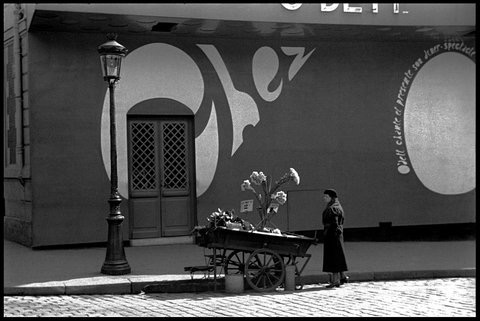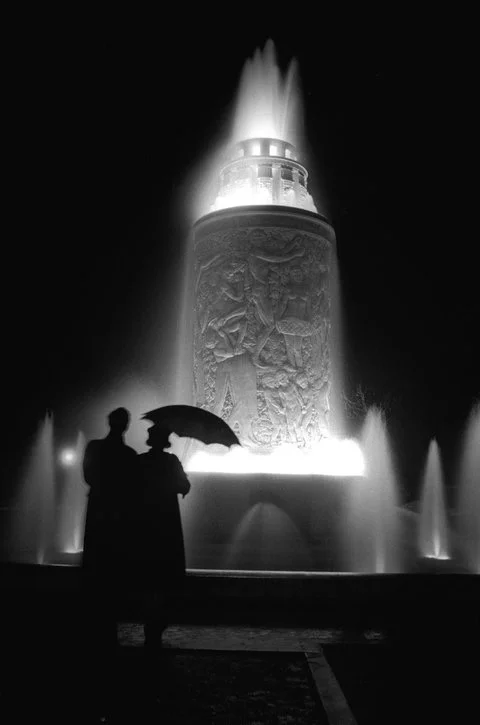By Sarah Moroz
“Nun” New York, 1942 Estate of Fred Stein
“Mehr Licht” — more light — were Goethe’s famous last words. That deathbed declaration was also the title of Fred Stein’s book, featuring images taken along the streets of Paris and New York, which was published posthumously. What could be more fitting?
The German photographer’s oeuvre has been largely overlooked, but more light is being shed on his work in an exhibition at the Maison Doisneau, just outside Paris, featuring Mr. Stein’s black-and-white images taken on both sides of the Atlantic.
He was born in 1909 to a Jewish family in Dresden, where he developed an early interest in politics and became an anti-Nazi activist. He studied law in Leipzig but was denied admission to the German bar because of anti-Semitism. In 1933, he married Liselotte Salzburg, known as Lilo, and the two fled their native Germany for Paris under the guise of a honeymoon, from which they never returned.
Although Mr. Stein spoke impeccable French, he couldn’t practice law in the French system either. Instead, he reinvented himself as a photographer, buying a 35mm Leica and opening Studio Stein (where the bathroom doubled as the darkroom). He photographed Parisian street scenes: a capped chauffeur ambushed by two inquisitive small dogs; a close-up of a woman asleep in a park with an unlit cigarette in hand; a couple embracing under lamplight. He also documented more politically-charged realities, like the Popular Front movement. In 1939, he was interned in a camp, but thanks to the International Rescue Committee managed to escape France along with his wife and infant daughter. They headed to New York via Marseilles on the S.S. Winnipeg, the Leica and some negatives in tow.
“Man in Pushcart” New York, 1944 Estate of Fred Stein
In New York City, Mr. Stein once again explored a new metropolis, documenting Little Italy, Chinatown, African-American life in Harlem and Jewish communities in Brooklyn. He photographed children splashing water along the sidewalk’s edge; a woman typing al fresco in Central Park; a shoeshine boy napping; an evangelist half-hidden by his all-caps doomsday sign “THERE IS NONE RIGHTEOUS, NO, NOT ONE.”
Despite hardships Mr. Stein endured, his son, Peter, noted simply: “He was an optimist. … His images leave you feeling uplifted.” His work has a humanist gaze, tinged with a sly sense of humor, a faith in community and joie de vivre. Marianne Rosenberg, whose gallery, Rosenberg & Co., represents his estate in New York, was moved by his “genuine tender, gentle touch” and described his non-portrait work as “deeper, richer and broader than just photographs of street scenes.” Cynthia Young, a curator at the International Center of Photography who reviewed the Stein archive, agreed: “Like many photographers, Stein was interested in people and how people survive, what amuses them. It is this curiosity in people that feeds them.”
Mr. Stein generally worked without assignment, shooting only what interested him. He often showed up with a press pass and a camera to conferences held at the German consulate, PEN, and the United Nations. He would do portraits of speakers on the spot, and then offer his work to publishers for book jackets, or photo editors at magazines. “He made a terrible living,” his son said. His wife, a college professor, supported the family and assisted her husband in the darkroom.
“Chez” Paris, 1934 Estate of Fred Stein
At the end of the 1940s, Mr. Stein got off the streets and finally opened a portrait studio, where he photographed writers, artists, scientists and philosophers, including direct requests from Norman Mailer, Thomas Mann, Hannah Arendt and Marc Chagall. His portrait session with Albert Einstein — arranged because Einstein’s assistant was the photographer’s classmate in Germany — was supposed to last 10 minutes. It took two hours: Their conversation was said to have been peppered with politics and dirty jokes in German. Similarly, with Le Corbusier, the two spoke so long that Mr. Stein took the architect’s portrait only as he was leaving the shoot.
For all the big names he photographed, he remained at the margins. His archives of negatives, contact sheets and prints were kept in shoeboxes and largely forgotten after his death — at 58 — in 1967. His son has spent his own retirement poring over them and is making a documentary about his father. Some 40 prints were shown in 1995 in an exhibition at the International Center of Photography, “Fred Stein’s New York,” and a larger show was at the Jewish Museum in Berlin, “In an Instant: Photographs by Fred Stein,” in 2013.
“Fountain” Paris 1935 Estate of Fred Stein
Today Mr. Stein’s photographs provide a record of the everyday pageantry of 1940s New York and Paris between the wars, portrayals of a bygone era of big city life. In his time, photographers were more often seen as technicians rather than artists. However, his own consideration of the medium was ahead of the curve: He once gave a lecture at the New York Public Library titled: “Is Photography Art?”
“It is remarkable that Stein chose the purist’s route in his photography,” Ms. Rosenberg noted. “Stein was trying to capture people and the essence of their lives; in so doing, he could not avoid picking up in his images the events and conditions which formed the universe inhabited by his subjects.”
“Fred Stein, Paris-New York” is on view through Sept. 24 at La maison de la photographie Robert Doisneau in the Paris suburb, Gentilly



